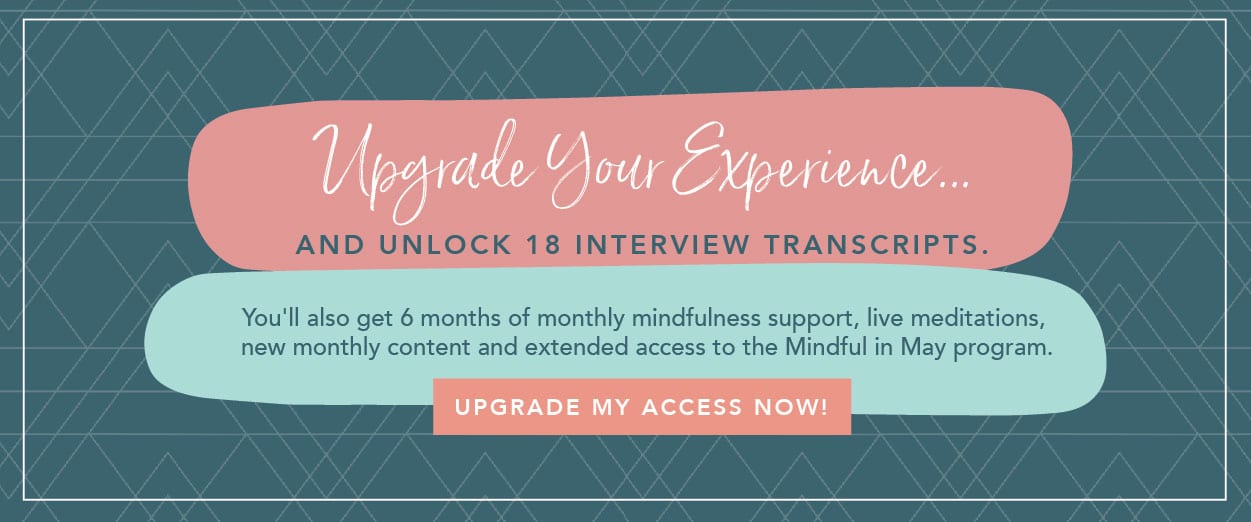Day Nineteen
Day 19: Dr Elise Bialylew interviews Harville Hendrix and Helen Hunt
In this video, you’ll learn:
- The secret to a happy, healthy, fulfilling long term relationship.
- A powerful technique to improve your communication and build greater resilience in your relationships.
- The neuroscience of relationships and practical tools to manage difficult times.
- How mindfulness can support greater love and connection in your life.
Prefer to listen, rather than watch? Click the play button below.
Want to read the transcript from this interview? Mind Life Project members receive access to interview transcripts and 6 months of mindfulness support, live meditations, and more👇
[accessally_missing_any_tag tag_id='707' comment='MLP 2021'] [/accessally_missing_any_tag][accessally_has_any_tag tag_id='707' comment='MLP 2021']Mind Life Project Bonus Content:
[/accessally_missing_any_tag][accessally_has_any_tag tag_id='707' comment='MLP 2021']Mind Life Project Bonus Content:
Click here to download the transcript of Dr Elise Bialylew's interview with Helen Hunt and Harville Hendrix.[/accessally_has_any_tag]
Your Meditation for today
Breath By Breath with Tara Brach
Dr. Tara Brach is a Clinical Psychologist whose teachings blend Western psychology and Eastern spiritual practices, mindful attention to our inner life, and a full, compassionate engagement with our world. Tara founded the Insight Meditation Community of Washington, DC , which is now one of the largest and most dynamic non-residential meditation centres in the United States. Tara’s podcast receives over 3 million downloads each month. She is also the author of the books Radical Acceptance, True Refuge: Finding Peace & Freedom in Your Own Awakened Heart and Radical Compassion: Learning to Love Yourself and Your World with the Practice of R.A.I.N.
MINDFUL CONVERSATIONS
In today's interview, you’ll hear from Harville and Helen LaKelly Hunt about the power of safe conversations as a foundation to healthy, flourishing relationships. They talk about the importance of relationships being a “safe space”, and describe what they call “physics of the between” - how two people can learn to successfully navigate the energy field between them.
“The quality of the interactions…determines whether or not this ‘betweenness’ is going to be dangerous or safe. If dangerous, then you’re going to defend; if it’s safe, then you’re going to connect… If it isn’t safe, it sucks. Then, of course, the question is, how do you make it safe, and how do you keep it safe?”
- Harville
Their ideas are built on many years of experience, research, and the strategies they have discovered and applied to save their own marriage.
Don’t miss this one!
Mindful Conversations Exercise - By Elise Bialylew
Conversations are a great opportunity to practise being mindful, and mindfulness, in turn, supports us in experiencing intimacy.
Our lives run at such a hectic speed, with competing forces pulling our attention in all directions, that bringing our full attention to someone is truly rare. By being mindful in our conversations, we can develop empathy as well as insight into and understanding of the perspective of those we interact with.
This is a challenging practice, but one that can deepen and enrich both our personal and professional relationships.
Experiment today with these twelve steps to having a mindful
C.O.N.V.E.R.S.A.T.I.O.N.
C: Clear intention to be mindful.
Set a clear intention about how you are going to use your attention in this conversation. Recognise that you are going to make an extra effort to be fully present.
O: Open to the other person.
Often during conversations we can be caught up in our own concerns and thoughts. When we mindfully communicate, we consciously open our awareness to include a sense of our own body and emotional state, while also making space to be open to the other person.
N: Non-verbal communication.
Pay attention to the person’s non-verbal communication: their posture, eye contact, and facial expressions. A large part of communication is transmitted through our non-verbal gestures and signs.
V: Voice quality and content.
Notice the pitch, volume, pauses and the energy in the other person’s speech. Pay attention to whether the content of their words is congruous with the way in which they are saying them; for example, someone may tell you they are really happy, but their voice tone may communicate the opposite.
E: Engage with a beginner’s mind.
Remember to bring a beginner’s mind to the conversation. Activate your curiosity and allow yourself to be surprised by the other person. Drop any assumptions you may have about the other person or how a conversation is going to unfold.
R: Resist interrupting.
When we are in conversation, it can be easy to fall into habitual ways of communicating. Some of us have a habit of talking too much and not allowing enough space for the other person to express themselves.
For others, it may be a habit of listening and not sharing our thoughts, because of shyness or a belief that what we have to say isn’t valuable.
A common conversational habit is the tendency to interrupt, reflecting our general lack of patience. We can bring more awareness to the way we communicate by noticing our urge to speak, and at that moment, taking a breath and reflecting on whether this is interrupting the other person.
S: Speak the truth.
Sometimes we don’t speak the truth because we want to avoid conflict, or we don’t want to be disliked by others. Be aware of what you are saying and stay connected to what is true for you.
A: Allow pauses.
Many of us are uncomfortable with silence and so we speak to fill the space. Notice if you have a tendency to fill the space and don’t be afraid to pause in conversations.
T: Tune in to your body.
When in conversation, it can be easy to lose touch with your own feelings. In mindful conversations, you’re invited to be present to the other person’s non-verbal signs and also maintain some awareness of your own feelings and body sensations.
This can be particularly helpful in difficult conversations where you might be emotionally triggered. By staying aware of your own emotional state, you can respond more effectively to others, especially when you’re under pressure.
I: Invite a non-judgmental attitude.
Our minds have a tendency to constantly judge others. This judging mind stems from our ancient survival instincts: we are constantly scanning for danger in our environment. However, we can be quick to judge others in conversation, and this closes our capacity to really see the person as they are.
O: Observe your mind’s tendency to drift.
During mindful conversations, we are using the other person as the object of our meditation. Just as our attention wanders during meditation, when you notice your mind has drifted away from the conversation, gently bring your attention back to the words or physical presence of the other person.
N: Notice when you feel emotionally triggered.
Conversations are a complex exchange between people, and without realising it, we can be emotionally triggered by people’s words or responses.
Pay particular attention to the feeling of being triggered while in conversation with others.
By maintaining a sense of your emotional state throughout conversations, you are better resourced to respond wisely to challenging interactions.
stay on track
[progressally_objectives]
[progressally_progress_pie_chart size="80"]

DONATE HERE
If you'd like to make a donation, you still can! Every $50 donated will bring clean water to one person for life.

Bonus Interviews
Watch Elise's conversations with four leading well-being experts: Shauna Shapiro, Linda Graham, Frank Osteseski, and Jon Kabat Zinn.

 Harville Hendrix is a New York Times best-selling author, international speaker, clinical trainer and couples therapist. Hendrix is best known for the book Getting the Love You Want, which has sold more than 4 million copies and gained in popularity during Hendrix's 17 appearances on The Oprah Winfrey Show. He has produced 10 written works in partnership with his wife and American activist, Helen LaKelly Hunt. In addition to their development of Imago Relationship Therapy, Harville and Helen also serve as Chancellors and Distinguished Professors of Daybreak University.
Harville Hendrix is a New York Times best-selling author, international speaker, clinical trainer and couples therapist. Hendrix is best known for the book Getting the Love You Want, which has sold more than 4 million copies and gained in popularity during Hendrix's 17 appearances on The Oprah Winfrey Show. He has produced 10 written works in partnership with his wife and American activist, Helen LaKelly Hunt. In addition to their development of Imago Relationship Therapy, Harville and Helen also serve as Chancellors and Distinguished Professors of Daybreak University.

